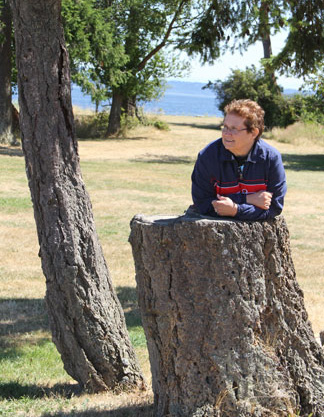
About
About this project: The copyright date on the first edition of Integrating Technology for Meaningful Learning was 1996 which means it was actually published in 1995 which means we were working on the book in 1994. That seems like a long time ago and in the world of technology it really is. We wrote 5 editions of the book for Houghton Mifflin. The concept of “technology integration” was new at the time of the first edition and we think we were the first to identify this concept in the title if not to use it as a core concept in organizing the content of the book. Now, “integrating” and “meaningful” appear in the titles of several books written for the future and practicing teacher market. Address the role technology might best play in education and understanding how technology might facilitate learning have remained consistent themes for us.
Sometime in approximately the middle of this process, we began to question the format we were using to present our ideas to teachers. At first, our concerns regarding the adequacy of a traditional textbook as a way to engage teachers were related to a) the mixed message in using a traditional book to convince teachers that technology (not necessarily in the form of a book) could provide students important learning experiences and b) the mismatch between the pace of change in technology and financial realities associated with the time necessary to create a book and then receive a reasonable return on this investment. If we truly believed in other ways of conveying information and engaging learners, we felt we should be directly modeling these methods rather than just describing them. We also were frustrated publishing a new edition describing software products that had been taken off the market or describing the state of copyright law when new legislation had since been passed. Over time, our list of concerns grew. With the greater and greater commitment to Internet resources and services, it was possible to allow readers access to the same working examples we were describing. Learners should have been able to read about online services and then to try the same examples we had described.
We did try. At one point, we obtained a commitment from a second publisher to develop a project involving a true combination of book and online resources. By “true combination” we mean a meaningful trade-off in which there is less book and more online. This is not the same as a standard book and ancillaries. You really have to go “all in” if you want to create the hybrid product we had in mind at what we hoped would be a lower cost to the student. We had to back out of this original opportunity for legal reasons. Despite our intention to create a new product from scratch, we were told what we had in mind would amount to us competing with ourselves involving two companies and this was not appropriate. It is difficult being put in this position. I knew that authors wrote books for two different companies so the legal basis for this position was not obvious. However, it did not seem worth the hassle of attempting to resolve what our publisher argued was unacceptable.
This brings us to the present (or nearly so). The book business is undergoing an obvious upheaval with companies consolidating with other companies to stay afloat. Houghton Mifflin was sold, spun off, and resold - twice if I remember the timeline correctly. It is now a part of Cengage. New ownership seemed like a new opportunity.
We tend to describe what we want to create as consisting of a Primer (a paper or ebook product), protected web content provided by the publishing company (users would buy the Primer and then be given access), and examples available via other free online services (e.g., Google docs, Flickr). We were given the go ahead to pursue this approach which we thought would result in a very different set of resources, but something that might be collectively described as our 6th edition. Creating this set of resources is far more work than generating a revision of an existing book which pretty much amounts to deleting and adding with limited “deep” structural changes. We were told after working on this new model for about a year and getting to the point that we had about ⅔ of the work completed that Cengage had decided that they could not complete the project. This was very frustrating given the initial commitment and thorough discussion of what we intended to do. The major obstacle appeared to be our expectations for online resources. Cengage had intended to use what we would describe as a “content management system” to offer the online resources. A content management system works something like a course management system (e.g., Blackboard) and typically assumes a templete-based approach with a database back-end. Our description may be a little geeky, but it basically implies that the system is great for high-volume clients but lacks the flexibility one expects when online content is created page by page. There was also the matter of “permissions”. To do a reasonable job of exploring the resources available online, it was our intent to include a significant number of tutorials and multi-media descriptions of various products and services. Publishing companies typically take on the responsibility of obtaining permissions - they contact the companies and individuals involved to secure permissions to use imagery. They need to do this for legal reasons and the assurance that permissions have been obtained is one of the things you pay for when you purchase a book. At some point it was evidently just to much.
The resources we offer here are a version of what was intended as the protected online content. We are still working on the associated Primer and are not certain at this point what will happen with this component of the project. The Primer does function to provide the structure and tie things together which we understand is an issue. We hope to eventually deal with this issue. We admit that we have not obtained permissions for the resources you see here. We offer them to the public in the same spirit as those providing the thousands, if not millions of instructional videos and web page tutorials one can find online. This component of our work is no longer commercial and we will simply remove anything that any company does not find acceptable. We obviously are describing resources we are encouraging educators to use.
About the authors: Mark and Cindy Grabe are both involved in educational applications of technology and the preparation of teachers, but they do have somewhat different perspectives. Mark Grabe is a university faculty member with responsibilities in the Departments of Psychology and Instructional Design and Technology at the University of North Dakota. He brings to this collaboration the theoretical perspectives and research experiences typical of someone working in a university environment. Cindy Grabe just retired from the Grand Forks, ND, school district where she spent the last 19 years as a full-time technology facilitator (coordinator) for the Grand Forks Schools. The final eleven years of this period she split her time because the school district and the College of Education and Human Development at the University of North Dakota and she continues her employment at the university. Her experiences working with teachers includes a good deal of international experience involving travel to Russia, Japan, China, and several other countries. She continues to work with some of these teachers online. Cindy has been recognized by Apple as an Apple Distinguished Educator and by Google as a Google Certified Teacher.


You are correct - these pictures were not taken in North Dakota!
